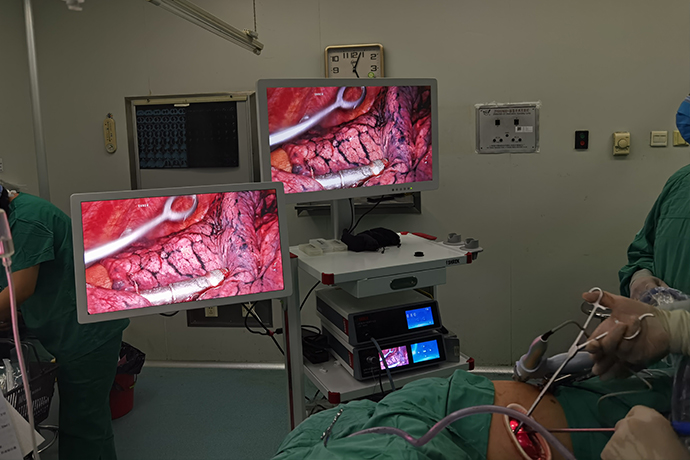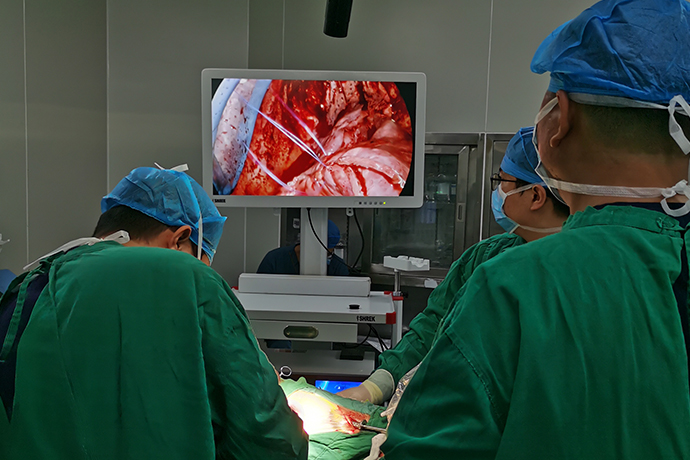[Thoracoscopic Surgery in Thoracic Surgery] 4K ultra-high-definition thoracoscopic left upper lobectomy
Release time: 19 Dec 2023 Author:Shrek
4K ultra-high-definition thoracoscopic surgery is where doctors observe anatomical structures through medical monitors and thoracoscopes, and use special surgical instruments to complete complex intrathoracic surgeries under chest wall casings or tiny incisions.

Compared with a doctor's vision during a major surgery, the doctor's head must keep a certain distance from the surgical field during open surgery, and there is a certain blind spot when observing the deep structures of the chest. 4K ultra-high-definition thoracoscopy surgery is equivalent to extending the doctor's eyes to the patient. It has an amplification effect in the chest cavity, making the surgical operation more precise. For patients with surgical indications, the resection can be more complete, greatly reducing the patient's trauma and promoting the patient's rapid recovery.
What are the advantages of 4K ultra-high definition thoracoscopic surgery?
1.Surgery is less invasive
Ordinary thoracotomy surgery is very traumatic. The incision is about 20cm, and the chest wall is severely damaged. All layers of chest wall muscles are cut off, and the intercostal space is forced to open 10-20cm. The postoperative pain has been difficult to resolve.
In 4K ultra-high-definition thoracoscopy surgery, a 1.5cm incision is generally made on the chest wall to insert the thoracoscope, and then 1-2 small incisions of about 1.5cm-4cm are made to complete thoracic surgery equivalent to traditional surgery. Sometimes, it can also be performed on the chest wall. The surgery was completed through a single port.
2. Mild postoperative pain
Due to the large trauma to the chest wall during ordinary thoracotomy surgery, the intercostal space is forcibly opened during the operation, resulting in obvious postoperative pain. The chest pain can last for months to years, and most patients have limited mobility after surgery. Because there is no need to open the intercostal space during thoracoscopic surgery, the patient's pain is significantly reduced after the operation. The patient can get out of bed and move around on the day of the operation, and can return to normal work 2-4 weeks after the operation.
3. Little impact on lung function
Compared with conventional thoracotomy surgery, thoracoscopic surgery preserves the integrity of the thorax and the patient's respiratory function to a large extent. The patient's postoperative lung function and mobility are better than those of patients undergoing conventional thoracotomy surgery.
Case: 4K ultra-high definition thoracoscopic left upper lobectomy
Upper left lung requiring resection
Medical records
1. Basic situation
A 49-year-old female patient was admitted to the hospital 1 month after physical examination revealed a tumor in the posterior segment of the left upper lobe of the lung.
2. Past history:
Denies any history of diabetes or hypertension; has no history of smoking, other tumors, or family history.
Surgical interpretation
1. Approach exploration, three-hole arrangement
2. Remove lymph nodes
3. Expose the hilus
4. Disconnection of proper segmental veins
5. Disconnection of the anterior end artery of the upper lobe of the lung
6. Bronchial disconnection
7. Disconnection of the proper segment of the left upper lobe of the lung
8. Lymph node dissection
9. Inferior pulmonary ligament separation and lymph node dissection
10. Water injection and inflation inspection
Precautions after lung resection mainly include the following points:
1. In the short term after surgery, attention should be paid to ensuring the smoothness of the respiratory tract. Patients should fully cough and perform respiratory function exercises.
2. Patients need to get out of bed early, which can not only promote gastrointestinal recovery, but also prevent acute pulmonary embolism caused by venous thrombosis in the lower limbs.
3. Patients should pay attention to postoperative nutrition and eat more balanced, rich, and light-tasting foods, such as lean meat, fish, beef, mutton, etc. You also need to eat vegetables and fruits to ensure the supply of vitamins and fiber.
4. Patients need to pay attention to regular review after surgery. If any discomfort occurs, they need to go to the hospital for further examination and treatment in time.
5. After lobectomy, appropriate treatment is required based on the nature of the lesion. If it is a chronic infectious disease, such as tuberculosis, long-term oral anti-tuberculosis drugs are required. If it is a malignant tumor, follow-up observation or chemotherapy, radiotherapy and other comprehensive treatments are required depending on the severity of the disease.

- Recommended news
- 【General Surgery Laparoscopy】Cholecystectomy
- Surgery Steps of Hysteroscopy for Intrauterine Adhesion
- [Gynecological Hysteroscopy] Techniques for Preventing and Treating Complications of Hysteroscopic Surgery
- [Gynecological Hysteroscopy] Hysteroscopic Adhesiolysis
- [Gynecological Hysteroscopy] IUD Removal under Hysteroscopy